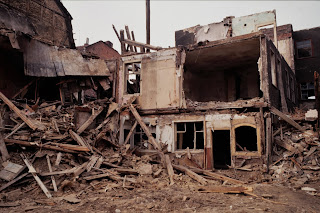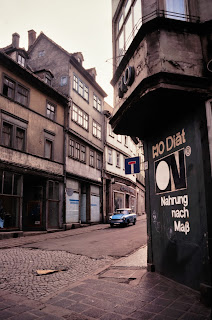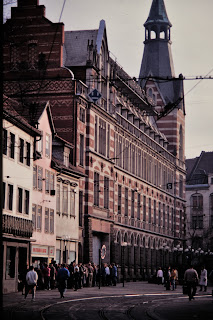The end of freedom, equality and fraternity
The official parliament of the DDR was the Volkskammer. On 18. March 1990 the DDR had their first free election. For the first time several parties actually competed for the favor of the voters. Of course there had been elections before, but the SED, “Sozialistische Deutsche Einheitspartei” usually won with a majority of more than 99%.
The elections were a consequence of a combination of the new politics of Perestroika (restructuring) and Glasnost (openness and transparency) of the Soviet leader Michael Gorbatchov in combination with the disintegration of political power and economy in the DDR. Like for many other socialist countries which were completely dependant on the cooperation with the UdSSR, also for the DDR the new soviet politics resulted in decreased economic and political support.
Streets in Erfurt
The official Russian newspaper at the time was the “Prawda”, it’s German counterpart was the “Neues Deutschland”: A conversation at the newspaper stand: “Why is the price of the Prawda 10 Pfennige, while the price of Neues Deutschland is fifteen?” Answer: “For the “Neues Deutschland” 5 Pfennige of translation costs are added”. (Uwe Tellkamp)
Increasing protests against the worsening situation and mass emigration had led to the replacement of Generalsekretär, DDR leader Erich Honecker, by his deputy Egon Krenz in 1989. A new government under Hans Modrow was formed which was controlled by what was called “Runder Tisch”, an assembly of new parties, the government and church leaders as moderators. One of the first consequences was the dissolution of the STASI surveillance and intimidation apparatus.
I had spent the years 1988-1989 in California. Staying abroad was a big thing and during that time I got disconnected from what was happening back home. One day in fall 1989 I came back to the house of my friend Wolfgang where I lived at the time. Wolfgang, who had studied in Berlin before, sat in front of the television, flabbergasted. It showed people standing on the Berlin Wall. Not long ago they would all have been put in jail, if not killed. The events came totally surprising for us. But only a couple of days later the first LA supermarket started to sell little plastic bags filled with coloured concrete rubble, supposedly from the destruction of the wall.
Hauptmarkt in Gotha
In the epic novel “der Turm” the writer Uwe Tellkamp draws a panorama of the last 7 years of the disintegrating world of the DDR. Members of three generations are drifting towards the maelstrom of the 1989 (r)evolution, some creatively, some powerlessly. They live in a world of permanent shortage, intimidation, patronism and secrecy.
A few months after the fall of the wall I returned to Germany. In the begin of 1990 a friend suggested to drive across the now open frontier to spend a weekend in Thüringen, the area on the other side. My friend knew somebody at the University in Ilmenau. From there we went to Schleusingen, Gotha, Eisenach, Weimar and Erfurt. The few months had not been enough to change things. Uwe Tellkamp has immortalized what now, after more than 30 years, is gone.
The government of the DDR was not a fan of historic city centres. With the exception of a couple of showcases like Wernigerode or Weimar, medieval town centres were in a deplorable state. There was no buildings material and no support to renovate historic town centres. People still lived in buildings several hundred of years old, unwilling to move into the new apartments blocks built for them in new anonymous suburbs. Roofs with missing tiles were leaking, most of the buildings were not painted for decades and had assumed a uniform brown grey patina. Sometimes windows were broken and replaced by cardboard. Abandoned buildings had started to disintegrate, roofs collapsed, part of the plaster and reed filling between wooden framework had fallen out and opened the interior to the elements.
It was still winter. Above all hung the sharp cent of coal fires. Sometimes piles of coal bricks were waiting outside to be moved to the basements. The smoke of brown coal, with a low calorific value and high soot and dust emissions, polluted the air. Plastic was fabricated by VEB Plaste und Elaste. Inside buildings or public transport was a very particular smell, probably from softeners used in the PVC.
Outside towns paved roads were full of potholes, inside most streets were cobbled. Missing cobblestones were mended with asphalt patches, if they had been mended. Over these uneven surfaces roared the ubiquitous Trabant cars with the typical sound of their two stroke engines, leaving behind a trace of blue haze from the exhaust. These cars, built between 1957 and 1991 by manufacturer VEB Sachsenring in Zwickau, became the symbol of a backward, stagnant economy. With its duroplast body on a one-piece frame it was a modern construction in 1957. All together 3096999 were built. The construction rarely changed during the long years of production. An average worker had to wait more than 10 years to get a new one. Consequently used ones were sold for up to three times the price of a new one. In 1990 those who finally received their long expected new one were an unhappy lot. Soon their savings in east German Mark would be exchanged at a rate of one by one against the west German currency and an invasion of more up-to-date western cars would start. Only a few years later a Trabant would be scarce on the roads of eastern Germany.
In 1990 the market place in Schleusingen was full of Trabant cars
Wartburg and Trabant in Schleusingen
The second brand of cars made in DDR were the Wartburg. The company was named after the famous castle in Eisenach, the seat of the manufacturer. Production of the Wartburg cars also ended in 1991. The factory was bought by Opel. Even fitting the car with a more recent VW engine of the model Golf did not help. The out-dated manufacturing process could not compete with western standards.
Freight train full of Wartburg cars near Eisenach
A typical long distance train in the final days of the DDR
Erfurt main station
1990 still saw functioning public transport in the DDR. Little branch line brought trains into the most insignificant villages. They were slow but reliable. Also minor stations had a freight yard where goods arrived or departed by train. Only ten years later this would all be replaced by highways and the railway yards in ruins overgrown by weeds.
Erfurt city center with one of the few big department stores
Not only cars and building material was scarce. In early 1990 the few shops even in bigger cities like Erfurt had little on display. There was no choice but for the one item on sale, if any. I remember a store for clocks and watches which had just received a shipment of children’s alarm clocks. They had many of them, but nothing else. The scarcity led to a thriving barter trade. To get new roof tiles you could probably find somebody to exchange them for the spare wheel of your Trabant. He probably did not need the spare wheel, but could exchange it for a long needed winter coat.
Erfurt
The lucky ones who had free convertible foreign currency mostly from family or friends in the west could buy luxury items in the so-called intershops. That offered a good starting point for more bartering. Still in 1990 long lines formed at the doors of ordinary shops like bakeries when something fresh was on offer.
Two types of intershops, the foreign currency stores
But the longest line we saw was at the office of the east german airline Interflug in Erfurt. Borders were open now. For the first time in their life, people had the chance to exchange a seat in front of a black and white television in their coal fire heated living room in their old and grey home town for a seat on a plane to a warm resort somewhere south. Or maybe a flight to a new home where nobody asked what you had been doing between 1949 and 1989.
Lines in front of the airline office and a bakery
After the borders opened there was another way to earn money. People started to sub-let one of their rooms, frequently their own bedroom, to the increasing number of visitors. Restaurants and hotels were few, space was scarce and service abominable. These places were operated by the official HO organisation. We saw people waiting in line in the cold at the entrance of restaurants while inside most of the tables were empty. Access for people with western currency was never restricted. The food was always similar, with potatoes and pickled vegetables on the side. But already very soon after the border opened the number of restaurants increased, guests were actually welcome and the service improved. 30 years later there are websites which list the remaining places preserving the traditional DDR atmosphere, but hopefully not the corresponding service and quality of food.
This also was the time when the gold diggers started to arrive. Suddenly people had property, which they did not want to loose and insurance brokers made a fortune. Stuff nobody had needed for 40 years suddenly had to be bought from the back of vans. Fridges, televisions, music sets, furniture, clothes…. in particular west german trade and industry suddenly had to fill a universe of black holes and the GDP rose correspondingly.
First protests were heard. Unemployment rose to a level unknown in a society where a job was basically guaranteed for everybody. Was the DDR industry indeed so rundown that everything had to be closed and sold for 1 Mark to a western investor? What would happen to community owned businesses? A law regulated the restitution of buildings confiscated from their owners during the communist regime. The unclarity who actually owned buildings blocked investment for a long time.
Seeing this vanishing world was fascinating for us. Before the fall of the wall it had been difficult for citizens of western germany to visit in the east if you did not have a family member and therefore a reason to visit. One possibility had been the trade fair which was held twice a year in Leipzig. If you bought a ticket you received a visa for a stay in the Leipzig district. From west Berlin it was rather easy to go for a day trip to the eastern part of the city but you were neither allowed to leave Berlin nor to stay overnight. Even these rare occasions had involved meticulous questioning, a dissection of luggage and car and confiscation of items dangerous for the pure mind of socialism ranging from sausages to literature including Porno magazines.
The closed border had led to incredible situations. At the border of Thüringen to Bayern the village of Mödlareuth was cut into two halves for 40 years. Relatives could not meet any more. The eastern part of the village was in the border zone which was strictly closed to every visitor. A double fence with 3.3 m high concrete wall and watch towers at regular distances not only separated the former neighbours, but also prevented them from sending any kind of sign across the border.
In other villages the eastern part was demolished completely. My grand mother had owned the village pub in Hermannsreuth, at the german border to what is now czech republic. After the war the village pub was in the part of the village on the eastern side. My grandparents with their family packed a wagon with their most valued possessions and got a pair of cows to pull it across the border into the western part of the village in a misty night. Shortly afterwards the whole eastern part of the village was broken down. As late as 1986 a man was shot who got lost in the mist and had ventured off to the eastern side. Today the border is open again. At the point where the hiking path crosses the border a sign indicates where the houses of the disappeared part of the village (and the village pub) had been.
When we were visiting the elections were approaching. In every town new groups and parties tried to attract the attention of the voters while the old SED tried to save what could be saved. They had changed their name to PDS (Partei des demokratischen Sozialismus) and gained 16.4% of the votes in the elections of 18.3.1990. Winner with 40.8% was the eastern counter-part of the CDU, the party of west german chancellor Helmut Kohl, whose careful politics finally led to the german reunification.
Election party propaganda in Weimar 1990 ....
.... and in Eisenach
“Says the teacher: form a sentence with the two nouns party and peace! Fritzchen answers: my father always says: leave me in peace with the party” Uwe Tellkamp
It is interesting to look up the fate of the DDR’s last leading politicians. Erich Honecker sought asylum in the Chilean embassy in Moscow, but was extradited back to Germany in 1992 to stand trial for his role in human rights abuses. However, Honecker was suffering from terminal liver cancer and therefore released. He joined his family in exile in Chile, where he died in May 1994.
Proletarians of all countries forgive me
Egon Krenz had been Honecker's deputy before he replaced him in 1989. However, he was not successful in his attempt to retain the communist regime's grip on power and had to resign. To improve their reputation the SED expelled him on 21 January 1990. Afterwards he was put on trial and sentenced to six and a half years in prison for manslaughter for his role in the communist regime.
Hans Modrow had been the SED’s official in charge of the electoral process in 1990. In 1995 he was convicted of electoral fraud and perjury. Later he also was convicted of abuse of office. However, the SED successor organisation PDS nominated him as their honorary chairman and he became the president of the "council of elders" of the most recent successor party, the Left Party, since 2007.
“But people, when they are free, what do they do with their lives? If your aspiration is to be happy, then what is the expression of your happiness? They go hunting! The aristocracy, who had the most leisure, found their favourite pastime to be hunting. And the little people: they go fishing. What do you achieve with a revolution? An increase in the number of anglers, that's all. The improved lot of the worker is that he can devote himself to this simplest form of hunting. And for freedom, equality, fraternity....” Uwe Tellkamp
My mother was born in 1934. She liked travelling, theatres, restaurants. If her parents would not have packed their cow-drawn wagon on time and she might have ended up in the east her life would have been completely different. Somebody born after the first world war in Germany first would have experienced the horrors of a fascist dictator and the terror of his war. If the same person would afterwards have ended up in the soviet zone most of his life would have been characterized by suppression, scarcity and bondage. My mother would not have seen other countries, rarely been to a restaurant and been restricted to a very limited choice of entertainment. How can, in the year 2022, somebody idolize politics which would result in such a way of life?
Sources:
UweTellkamp, Der Turm, Suhrkamp Verlag, Frankfurt 2008
Link to the previous posts about Germany





















































